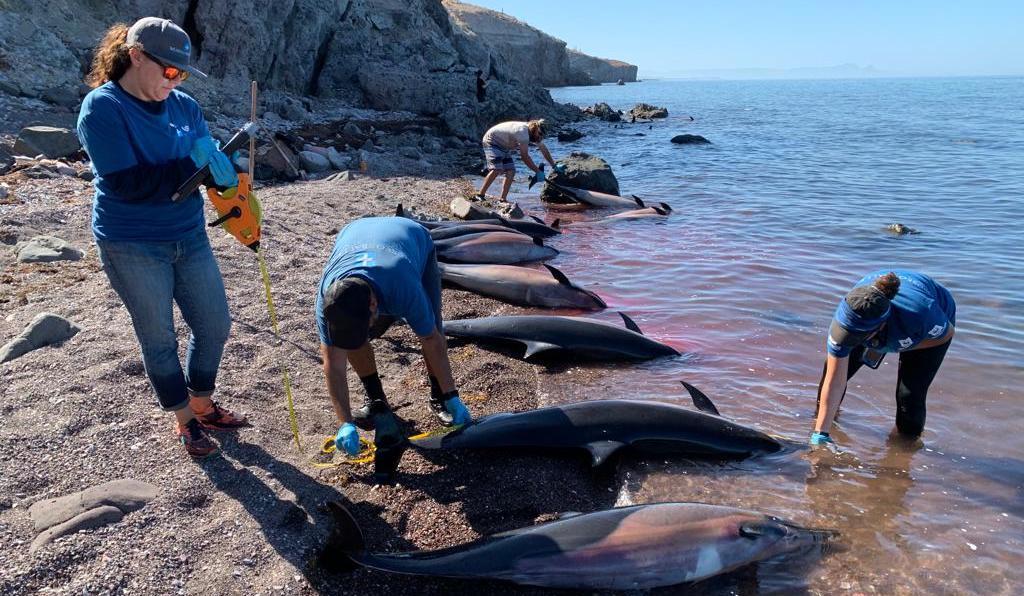A short-faced common dolphin baby floated without life for five days until October 17, 2022, it was discovered in a state of decay by a family enjoying the beach in the calm of the cove of La Paz, located in the southern part of the Baja California peninsula, in northwestern Mexico.
All live and dead strandings recorded in Baja California Sur are attended by the Marine Mammal Stranding Network, which is a multidisciplinary effort created by the Secretariat of Environment and Natural Resources (Semarnat) and the Federal Attorney's Office for Environmental Protection (Profepa), in which volunteers, scientists and institutions participate, acting under a care protocol.
The Care Protocol for stranding marine mammals determines the procedures for dealing with these strandings throughout Mexico, ranging from preventive actions to provisions on dead specimens.
It also establishes the response model according to the actors involved and the monitoring of live specimens, with the objective of avoiding the impact of ecosystems, animal health and public health.
However, there are logistical, equipment and budgetary aspects that could improve stranding care, said Dr. Aurora Paniagua Mendoza, president of Megafauna Marina, Care, Rescue, Ecology and Society (Mmares) A.C.
So far, a large part of the costs derived from attending these events have been absorbed by volunteer groups, he said.
In addition, stranding large species such as sperm whales, sea lions, elephant seals and some dolphins when found in rocky or sandy places requires the use of equipment, such as stretchers and special tables, which is currently not available.
Stranding care requires expanding and improving communication channels between the organizations that make up the Network so that there is better logistics, he said.
An important challenge lies in the need to promote campaigns to disseminate information that will help citizens identify a stranding and the mammal care protocol, which consists of making a report to C4 (911) or directly to the offices of Profepa, an institution responsible for the care and preservation of the environment.
This prevents the transmission of infectious diseases between humans and animals (zoonoses) or that species are manipulated without training and authorization from the authorities.
Consequences of a lack of support
If the above points of improvement are not addressed, what happened in previous cases will be repeated, where due to lack of economic resources and equipment there was limited attention to the specimens, without determining the cause of their stranding, explained Francisco Gómez Díaz, member of the Network and executive director of the Museum of the Whale and Marine Sciences, a non-profit institution that disseminates knowledge of marine megafauna.
So far this year alone, the area run by Gómez has cared for around 40 dolphins.
“It was already an unnecessary effort, perhaps, to perform superformal necropsies, because normally all of this costs and all of us who make up the network do so as volunteers and we don't always have the budget to carry out studies and analyses that have to be done in specialized laboratories, and even here they can't be done right here,” said Gómez Díaz.
Two cases of mass strandings occurred on February 13, 2018 when 21 dead stranded dolphins were found associated with an attack by a group of bottlenose dolphins, and four years later, on May 26 of this year, another mass stranding of 33 dolphins by algal outcropping commonly called red tide.
It is speculated that strandings are associated with natural reasons such as low or red tide, killer whale attack, loss, but also indirectly with anthropogenic factors such as fishing gear, the presence of boats, contamination by spills of hydrocarbons or other substances and garbage, dredging activities, etc., without sufficient information to confirm it.
Marine mammals are bioindicators, meaning that their presence, abundance and distribution reflect that something is happening or changing in the environment.
In this regard, it is important that there be better stranding care, since protecting mammals is not only important in ecological terms, but also economically because it is one of the main tourist attractions in the Bay of La Paz, said Paniagua Mendoza.



Comentarios (0)